Another year has come and gone, and a big ol’ stack of videogames with it. I made a point in April to keep a list of every game I played throughout the year, and by the time July or so rolled around, I had decided to make up this list of the Top 12 Games of 2012. There are a few rules I decided to put in place for this list, though I ended up breaking them. Heck, there somehow managed to be 14 games in my top 12. Obviously the rules are more like suggestions.
Going in, I had decided that the games which would populate this list would have to be games that I started and finished in the year 2012. They would also have to be games that I’d never played previously. While most of the list fits this rule easily because they were released in 2012, I did make a couple exceptions. Technically there is one game that I did not beat on the list. However, I am right at the end of it, and I haven’t pulled the trigger on the ending sequence because there is more that I want to accomplish and I’ve heard whispers that ending the game ends the game for reals. Justified. The other exception is a pretty major one: a collection. I couldn’t help but add it because 2012 is the Year of the Video Game Collection and it’s by and large the best one I’ve seen so far. Also I did play through two of the games included on it this year. Good enough.
I think that earlier on in the selection process I had another stipulation on what could qualify, but I’m pretty sure that I broke it so many times that I can’t even remember what it was. Probably would have cut down the eligible games to under a dozen anyway. That said, let’s take a quick peek at the honorable mentions. These are games that either didn’t quite make the cut, or games that I really liked but didn’t even come close to finishing. They all deserve to have words written about them, but this is neither the time nor place. So let us look at their boxarts and dream about what could have been.
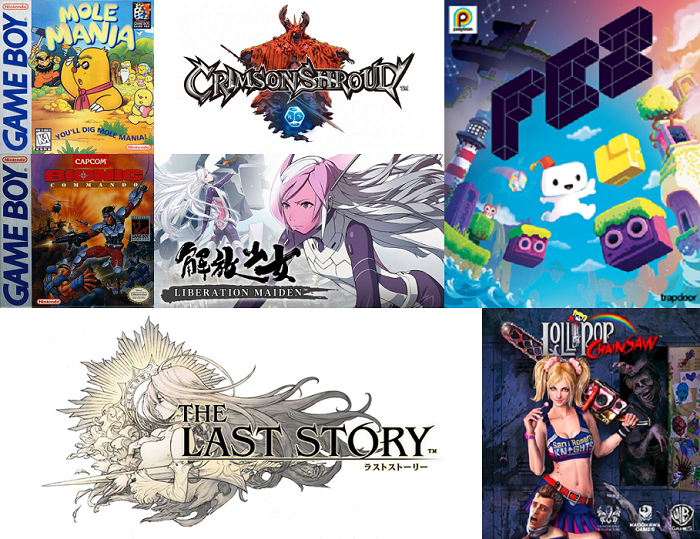
Now that we’ve got those losers out of the way, you can go ahead and check out what games earned the most of my affection and/or time last year. The list is exactly as Nintendo-centric as you might expect, but there are a couple games on here that will probably come as surprises. I’ll warn you now though, the total word count goes ever so slightly over 10,000 words, so if you’re in, be ready for the long haul. Maybe go get yourself a sandwich or a drink before you get started.
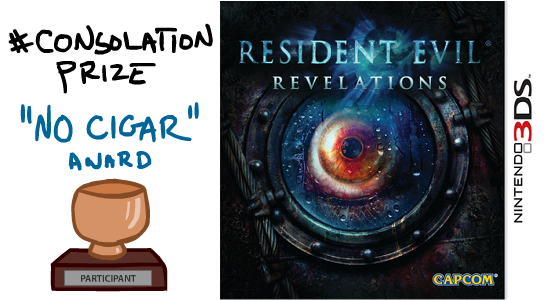
~ Resident Evil: Revelations ~
It took me a long time to decide to cut Resident Evil: Revelations from the top 12, and I felt so bad when I did that I decided I’d have to give it a consolation prize. Because RE Revelations tries really hard to simultaneously please everyone and be the best that it can be. Unfortunately, as much as I like it, I just can’t say that I liked it enough to be one of my favourite games from 2012.
I think the most telling thing that I can say about it is this: Revelations would be a really fun game if there weren’t any enemies in it.
That’s only part of the issue though. The real problem is that it’s trying to satisfy both fans of the classic RE style (slow and methodical) as well as fans of the current RE style (more action-oriented). Those two styles of gameplay don’t mesh together incredibly well. Playable characters move slowly and are a pain to control like in the classic games, but enemies are generally pretty quick and competent like in the newer ones. Ammo is common enough, but monsters can soak up tons of hits before they finally give up the ghost, and bosses can take hundreds of bullets before they fall. And this is on the normal difficulty level. I cleared most of the game’s chapters by the skin of my teeth, with a handful of bullets left over and all my healing herbs used up. So really, it almost seems as if Capcom built a modern Resident Evil and then decided that the player characters should move and have the durability of the classic heroes.
It’s not all bad though! While the story is a Resident Evil story (re: too complicated and mostly nonsensical), it’s got very little to do with the main RE storyline, aside from the fact that Chris and Jill are two of the protagonists. It’s nice to step away from the usual overwrought RE craziness and just take in a chapter of The Wacky Adventures of the BSAA. I also think that the enemy design is aces. From the lowly Globster to the infuriating Sea Creepers to the knight-like Scarmiglione, I love how the designs all stick to the piscine theme, all resembling or at least having some traits of underwater life forms. Even the Hunters got a fishy makeover! What I assumed would be the final boss was so huge and cool, I almost felt bad that it was evil and I had to slaughter it.The actual final boss isn’t quite as neat, but is easily the most frustrating monster in the game. Makes sense, I guess, but it’s been a long time since it’s taken me upwards of twenty tries to kill a final boss.
While the story mode seems a little unbalanced, there is hope! RE Revelations also includes a thing they called Raid Mode, which is not quite Mercenaries, but sort of is. Rather than being stuck in an enclosed and trying to survive like in Mercs, Raid Mode gives you a level to get to the end of. Whether you want to play it straight or avoid enemies is up to you most of the time, but it’s best to go in with guns blazing. Your character’s movement is still hopelessly slow and clumsy, but Capcom was nice enough to load you down with bullets and you’ll earn at least two new, stronger guns for every level you play. And if you get stuck? There’s a store which accepts both the in-game currency and 3DS Play Coins. So if you suck too much to afford that new shotgun, just take your 3DS out for a walk! Apparently it’s two-player too, but I haven’t tried that out yet. In any case, Raid Mode is a ton of fun, and alone worth the purchase price of the entire game.
So you can see how I’m a little wishy-washy where Resident Evil: Revelations is concerned. The main game has got some issues, but Raid Mode is just so damn fun that I needed to make sure that it at least gets a little shout out. It’s also so, so much better than Resident Evil 6.
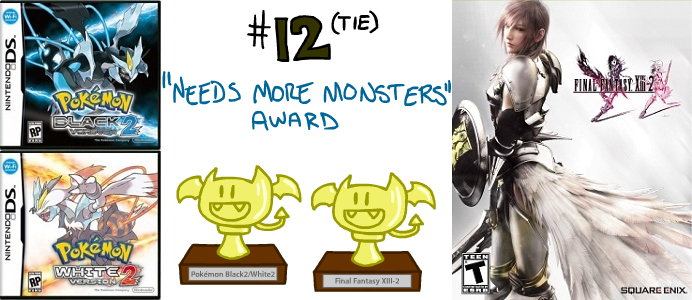
~ Pokemon Black 2/White 2 & Final Fantasy XIII-2 ~
Yeah, I know. I need to learn to be more decisive. But here’s the thing: I think that both of these games deserve a place on the list, but I can’t in good conscience give one the place over the other. I played them both with the greatest enthusiasm, and they’re both in that extremely small category of games that I beat within a month of purchasing them. Also, they’re both secretly all about catching as many monsters as you can.
Final Fantasy XIII was a game that divided FF fans. Most hated it, but a small contingent including myself absolutely adored it. I can’t explain why, exactly, but I did. Oh, wait, it was Lightning. I love Lightning. Anyway, I jumped on the super duper bonus edition of the XIII-2 on release day, which just happened to be the wife’s birthday. Oh, what a conundrum! The next day, I cracked it open and started plugging away. Reviews seemed to be copacetic that XIII-2 fixed (or attempted to fix) a lot of the things people didn’t like about the first one, but that it still had a handful of its very own issues. The number one problem here is the story; if you thought XIII’s story was a confusing mess, don’t even try XIII-2. Even I can’t defend it, and I’m the type of person who spent enough time reading supplemental material for XIII that I understand and really like that game’s story.
The big dirty secret about Final Fantasy XIII-2 is that it’s really about collecting and raising monsters. Not unlike Pokémon! Only here, they just kind of randomly join up with you, and you can’t own more than one of the same monster. Not that you’d ever really need to, since only one can be deployed at a time. Monsters level up by feeding them items, just like weapons in the original game. You can also feed them other monsters to confer the eaten monster’s special abilities to the feeding monster. In this way, you can assemble completely broken monsters that can render you/themselves nigh invincible, or simply tear the opposition to shreds. In that respect, I found XIII-2 to be way easier than the original, and that’s okay. The superbosses in this game were merely tough, as opposed to the endless frustration caused by those in the original.
As for Pokémon Black 2/White 2, it’s another mystery sequel of sorts. Not like FFXIII-2, where it’s a sequel that nobody ever asked for, but rather that it’s a sequel that nobody ever expected. Every Pokémon generation begins with a pair of games that are generally the same, but contain different Pokémon and sometimes other things. In this instance it was Black and White, and while they had the same story line, there were plenty of more significant differences between the two versions than in previous generations. About a year after the initial pair comes the third game, often the same game with a few extra areas and other minor changes. When Black 2 and White 2 were announced, I’m fairly sure that the collective fanbase’s jaw hit the floor. Rather than a puffed up rehash (which would have been an unexciting Pokémon Gray Version) these were actual sequels; with a slew of new content and a story directly continuing that of the first games. It’s a radical departure for Pokémon as a series, and it works.
Black and White had made another unprecedented change to the formula: instead of adding a new boatload of creatures to collect and then mixing in a bunch of the old ones, Black and White did away with the 493 Pokémon from the previous four generations and focused entirely on a new set of 156. Until you got to the end of the story, you couldn’t see any Pokémon that wasn’t native to the Unova region at all. Even afterwards they were limited in appearance and you had to trade most of them over from previous games. B2 and W2 buck that trend, and move a whole slew of the older monsters into Unova, doubling the size of the initial Unova Pokédex. Once you’ve completed the story here, even more become available. So many in fact, that catching all 649 of the little buggers doesn’t seem like quite as impossible a task as it did with the first games. There are just over 160 Pokémon that cannot be caught directly in either game, and most of those can be obtained through the Pokémon Dream World website, with the bulk of the rest being starters and ones you have to cheat to get anyway (Mew, Deoxys, etc). There is also a really great new Tournament mini-game included, but what does battling matter? This is about completing a collection!
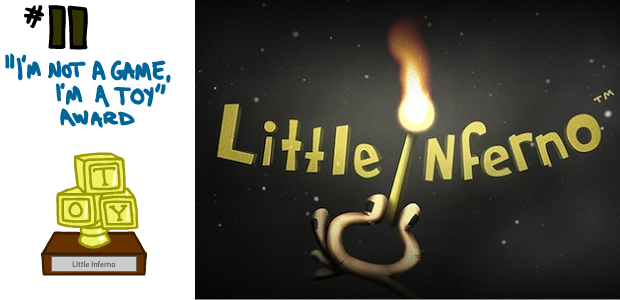
~ Little Inferno ~
I hemmed and hawed for a month before I finally gave in and bought Little Inferno. It helped a lot that it was on sale for $10 and I had a $5 eShop credit burning a hole in my virtual pocket. Most of the time I can get over a missed video game pretty well, but Little Inferno was boring a hole into my brain and refused to leave. Knowing what I do now, I think that not owning Little Inferno would have actively decreased the quality of my life.
Let me make this as clear as I can: Little Inferno just barely qualifies as a video game. It is more like a digital toy. Like something you’d get on the iTunes App Store, or one of the myriad bonus thingamajigs you unlock in the handheld WarioWare games. Only Little Inferno is quite a bit more robust than any of those. You can play with it just for the joy of playing with it, but there is a sense of progression woven into it that very tightly clings to the idea of it being a game. And we’re talking the base definition for game here, in that there is a “winning” condition. You can’t lose at Little Inferno and I’d be remiss to say that you actually win it, but there is a conclusion.
The game is marketed exactly as what it is: and entertainment fireplace. Imagine if instead of those holiday fireplace channels just sitting there, you could huck little virtual doodads into it and watch them burn up. That’s what Little Inferno is. You buy some junk, toss it into the fireplace, light it on fire, and then sit back and watch what happens. Whenever something is burned, it drops a coin for you, which provides you with cash that you can use to buy new junk to toss into the fireplace, and the cycle repeats. Every item spews out just a little more money than it cost, so you’re constantly working towards more expensive items without fear of overspending. The only time running out of money is an issue is when you want to buy a new item catalog or another item slot, which obviously don’t pay you back. In that case, you have to burn a bunch of cheap stuff again to get your dollars up, but it’s not so bad. I could burn that school bus over and over forever. Hilarious.
And speaking of being sadistic, the real joy in Little Inferno is watching how everything you burn reacts to the fire. Some things work like you’d expect; a family photo is distorted as it burns, and a miniature nuclear bomb explodes and vaporizes everything in the fireplace. Other are less obvious, like the bank that will either spout out coins or bombs when lit up. Or the can of spring snakes that is actually filled with… oh, I’d better not spoil it. That’s a good one. For the more goal-oriented of you, there is a story in Little Inferno, delivered through letters that come from a neighbour, the weatherman, and the CEO of the company that produces the Little Inferno. It’s mysterious and a little disturbing, though a little too brief for my tastes. There is also a list of combos that you earn stars for, which is filled out by burning specific objects together. It’s a nice little check-sheet to have, but I feel they missed an opportunity to do something even cooler with it. The objects just burn as usual when put together; I was hoping that the combos would trigger some kind of special reaction. But nope.
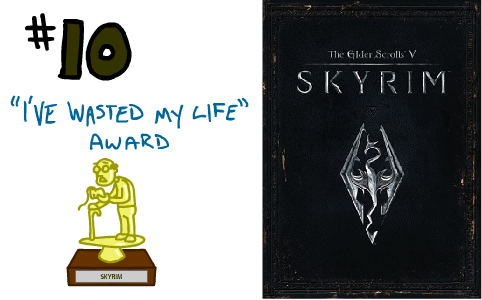
~ The Elder Scrolls V: Skyrim ~
I really don’t know what else to say about Skyrim that I haven’t already. I think I may have sunk more time into this than any other game ever, the only probable exception being Pokémon Blue. You know what? That’s the funny award title I gave Skyrim, so that’s what I’m going to talk about: how this game will absorb all of your free time.
If you haven’t played Skyrim yet, or any of the recent Elder Scrolls or Fallout games, what you’re missing is an absolutely massive RPG. Delving into the world of Skyrim is probably the most complete fake world experience that you’re going to get from a single-player video game. Skyrim (the country) is huge, and there are well over 300 map locations that you can find and explore. There are hundreds of unique people living in this world too, and most of them have at least one small favour to ask of you. One might need you to deliver a letter, while another could ask you to discover the secret of an object that could destroy the entire world. Also there is a system within the game that infinitely generates lesser quests for you to do. So you could literally play Skyrim forever. It’s more than a little frightening to think about.
The problem with this setup is that not everything you can do is satisfying. 90% of the predetermined quests are boring fetch quests or fetch quest chains that just have you hop back and forth between NPCs. The world does have a ton of depth, and plenty of interesting characters to meet and stories to tell, but it doesn’t take long to realize that the “get me some ale” quests aren’t the most compelling things to waste your time on. The game also has some really long loading screens, which are sort of justified by how ginormous and detailed the world is. But still, man, you’re going to be spending a long time with those loading screens.
The part that really stings is that with all the time that I’ve sunk into it, there is a ton of game left for me to see. The world is rife with black (undiscovered) location markers and large areas completely devoid of said markers. Not to mention all the caves, dungeons, forts, shipwrecks and towers that I found, left behind for later, and never came back to explore. Let’s not forget those two big ol’ DLC packs that I’m not going to play because together they cost as much as a whole game.
So if all I’m doing is complaining, then why is Skyrim even on this list? Easy, because it was so good at sucking me in. There are a handful of games that I can sit down and play for an entire Sunday, but with Skyrim, that quite often happened by accident. I’d jump in to explore a cave or run a couple short quests, then I’d look up and the day would be over without me even realizing it. Skyrim has got a lot of little things I can’t stand about it, but it proved an engaging enough experience for me that I saw it through to the end anyway. Will I ever go back to complete my tour? Probably not. It’s just like how you can’t see everything at Disney World unless you’re willing to spend an ungodly amount of time there, or bring a step-by-step guide with you. I’m more likely to go back in a couple years to roll a brand new character and start the quest anew.
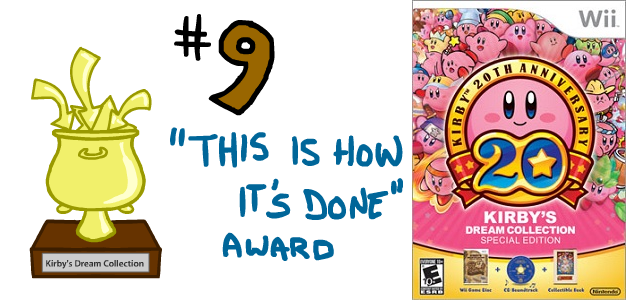
~ Kirby’s Dream Collection ~
I feel like kind of a dope for including this here, but hey, it’s the year of the HD Collection, so I suppose I should include at least one. Note, however, that Kirby’s Dream Collection is not in HD. Because it’s a Wii game, you see. Collection of games. Whatever.
Let us note right away that the silly award title I gave this collection is right on the money; if you want to assemble a collection of a certain game franchise, this is the one to look at to see how it’s done. Kirby’s Dream Collection comes with a super-cool cover and two excellent pack-ins: a “celebration booklet” and a compilation soundtrack CD. The CD has a whopping 42 tracks from throughout Kirby’s history, plus three additional orchestral tracks recorded specifically for it. Compare this to the CD that came with the Mario All-Stars package last year, which had a theme from 10 Mario games, plus 10 sound effects. It’s almost like Nintendo has a lot more respect for Kirby than Mario. The booklet that comes with KDC is great, and features concept art, production notes, and all sorts of other Kirby-related info. It’s only a shame that it’s so small (the size of a DVD case).
But the fun stuff doesn’t stop there! Oh no. The disc itself is crammed full of all sorts of other special goodies. The most obvious is the History of Kirby feature, which is like having a tiny little Kirby museum in a Wii game disc. It’s got a list of every game Kirby has starred in, complete with descriptions, 3D box recreations, and gameplay videos of each. Also, there are little tidbits of other Nintendo-related information, and some that aren’t even Nintendo-related. There are even three episodes of the crappy Kirby cartoon in there for good measure, though I don’t know why. I tried to get into it when it was new, I really did. But the fact remains that it was a Kirby cartoon that only barely featured Kirby. Guess making your main character a mute baby isn’t the best idea. Oops. The History of Kirby isn’t the deepest experience, but it’s still better than most of the bonus content in video game collections. Hell, it’s better than most bonus content on movie/TV DVDs.
Kirby’s Return to Dreamland, which released in 2011, had a bunch of challenge stages packed-in, just in case the main game was too easy I guess. There were eight or nine of them total; not quite one for each of Kirby’s powers. KDC ups that ante by including a whole new set of challenge stages, again power-centric, and still in the KRD engine. What’s better is that there are more of them, it includes a few cool race levels, and there is even an ability that wasn’t included in KRD: the Smash ability, which grants Kirby all his moves from the Super Smash Bros games. On their own, these aren’t too tough, but if you’re gunning for the coveted platinum medals, you’d better bring your A++ game. Perfect runs on these are tough as nails on even the easiest courses.
Where Kirby’s Dream Collection sort of falls short is in the actual games included. There are six on the disc: Kirby’s Dream Land, Kirby’s Adventure, Kirby’s Dream Land 2, Kirby Super Star, Kirby’s Dream Land 3, and Kirby 64. Granted, these are the core games of the series (less Return to Dreamland, natch), and they’re all pretty damn great. The thing is… why not include some spin-offs? I know Kirby’s Dream Course wasn’t the most popular, but why not stick it and Kirby Star Stacker in there instead of one of the cartoon episodes? I know it’s a little silly to complain about what isn’t there, but what can you do? Fortunately, the games that are there are solid. I’ve played them all multiple times before, and I’ll play them all multiple times in the future. Kirby and I go way back, and I’m happy that Nintendo decided to give Kirby the kind of collection he deserves.
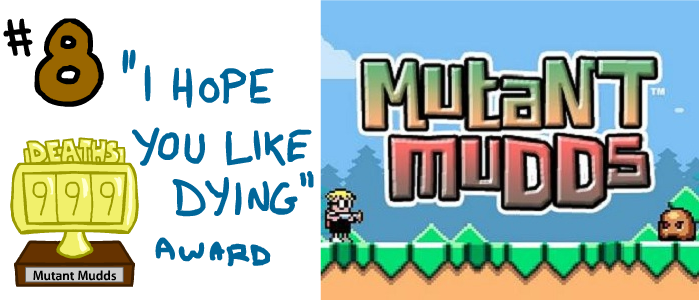
~ Mutant Mudds ~
Back when WiiWare was announced as a thing, I was all happy and excited at the possibilities of downloading cheap little games on a Nintendo system. My dreams were quickly shattered when Nintendo decided they were just going to let anybody publish any old crap through it. Sure, there were a handful of quality titles, but most of it was garbage. The situation was even worse with DSiWare, where you’d be hard-pressed to find anything worth playing buried under the mounds and mounds of awful shovelware and iOS ports (of awful shovelware). Needless to say, I wasn’t too excited about the 3DS’ eShop. On a happier note, I was so, so wrong.
While there are still plenty of crap games on the eShop, the quality ratio is far less dire than on the Wii or DSi. The first year of (North American) releases was actually quite strong, with high-quality titles like Dillon’s Rolling Western, Pushmo, VVVVVV, and Mighty Switch Force. My favourite of them all though, is unquestionably Mutant Mudds.
Mutant Mudds is an old-school platformer that contains shades of Mega Man, Virtual Boy Wario Land, and Gargoyle’s Quest all rolled into one scrumptious little package. The premise is simple: walk to the right, jump over holes and spikes, and shoot enemies. It’s a pretty simple concept, but it’s a tried-and-true concept that works just as well as it did 25 years ago. The game does shake things up a bit though. The biggest thing that separates it from other 2D platformers is that it takes place on three planes: the main stage, the foreground and the background. Virtual Boy Wario Land used a very similar mechanic back in the day, and I think at least two of the Paper Mario games use it here and there. As neat an idea as it is, it kind of misses the point by just making three different playfields. They’re never used as anything but a way to navigate stages on a third axis. It doesn’t detract from the experience, but I think if puzzles or combat actively used the mechanic, it would be even better.
The other thing you should know about Mutant Mudds is that it is merciless. You will die over and over and over again, because the level designers are brilliant and sadistic. In that regard, it plays out sort of like a bullet-hell shooter, where the key to surviving is not only in your reflexes, but also in learning the stages and how to navigate them most efficiently. There are also 100 gold diamonds in each stage, which unlock power-ups after collecting so many of them. You can only ever have one of the three power-ups active at once though, so even when you’ve unlocked them, you have to decide which one will be the most helpful to you on any given stage.
Renegade Kid recently released a free update to the game containing 20 stages, and while I was celebrating this news before they dropped, I have to say it was a disappointing update. Firstly, they all exist as secret areas in existing stages. Having to get to your new content is not a great design decision in itself, but the actual stage design is pretty lazy and cheap. Not only are there not enough different challenges, all of them contain at least a handful of blind jumps. which is a pretty crappy way to add difficulty. Factor in that these were all designed to use all three power-ups in tandem, and you can’t really help but walk away feeling like they missed the boat here.
As far as the main game goes, I guess most people didn’t like the difficulty as much as me, because Renegade Kid has announced that they are going to be adding checkpoints to the upcoming Wii U port. I suppose it’s a good idea overall, but I didn’t find that the levels were so long that they require checkpoints. In fact, I think it’ll throw off the balance of the game and make it way too easy. Word on the street is that they can be turned off though, and that’s the first thing I’ll do when I get the port. What? Some people buy Cave Story over and over again. I’m going to buy Mutant Mudds over and over again. What can I say? I think it’s a really solid game.
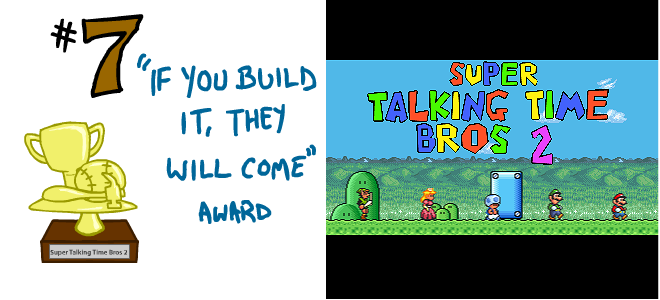
~ Super Talking Time Bros 2 ~
I’m a little wary of putting this one in here, but you know what? If fits the bill. It’s a video game, and I played it start to finish in 2012. If you don’t like it, tough noogies. For the uninitiated, the reason I’m not sure if it’s kosher to count STTB2 is because not only is it a fan game, but it’s a fan game that I helped to make. Maybe self-promotion doesn’t belong on this list, maybe it does. Who even cares? It’s not like I’m doing this professionally anyway.
That said, Super Talking Time Bros 2 is easily the best fan-made Mario game I’ve had the pleasure to play, if only because it’s the only one that was good enough to stick with through to the end (I didn’t even finish the original STTB). But really, it’s quite good! I had even more fun playing it than I do most official Mario games, so that’s gotta say something, right? To be completely honest, I even kind of hate the levels I built for the game when I go over it and see the baffling amount of creativity that the rest of the game has to offer. My stages are pretty to-the-point, whereas so many others make use of clever gimmicks, unusual power use, or even just excellent stage design to really elevate the art of creating Mario levels.
STTB2 is structured like most Mario games, in that it takes place over eight differently-themed worlds, each with a handful of levels to test your running and jumping skills. There’s a great amount of influence here from Super Mario World, especially when you consider that there are several levels with secret exits that all lead to the Star Road, and that there’s an even secreter world waiting for you when you’ve collected enough stars. Things go a little off the rails when you start seeing enemies from the Kirby series replacing Mario enemies, though it’s not as shocking once you realize that the game was originally going to be based on this webcomic. It’s lacking a little in the Metroid department, but that’s okay. The theme kinda sizzled out halfway through development.
To be honest, I just can’t help but feel that you need to see this one with your own eyes. I have a very convenient series of videos that showcase the entire game here if you want to check that out. I was going to embed the playlist in this page directly, but I figured that might be going too far.
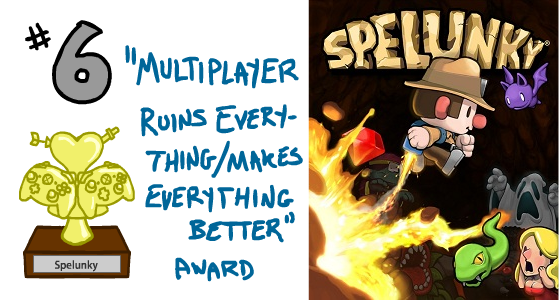
~ Spelunky ~
My first exposure to Spelunky was a series of Let’s Play videos. I’m sure a lot of people’s first exposure to Spelunky was through similar means, because there are just so many Spelunky videos on YouTube. By the time I got around to downloading and playing it for myself, there were already solid plans for an Xbox 360 version of the game, and while I wasn’t immediately looking forward to paying for a game that’s free on PC, time went on to convince me that it would be a case of Microsoft Points well spent.
Spelunky, if you haven’t heard of it, is a roguelike platformer. What that means, in simple terms, is that pretty much everything in the game is randomized and you have to start from scratch every time you die. And you will die. A lot. Spelunky doesn’t pull any punches, and the 360 version may be even tougher than the original. Some of that is because of some questionable design changes, but the core game is the same and just as brutal as ever. It has also been upgraded with some fairly pretty-lookin’ HD graphics, but I doubt that anyone who has a clue would say that the original Spelunky’s graphics are bad in any way.
The one ginormous, game-changing difference between the two versions is that the 360 port supports up to four players simultaneously. OG Spelunky is strictly a one-man operation, but the XBLA version lets you team up with one or two or three of your friends in hopes that teamwork will be the key to conquering the caves. Turns out that’s not really it though. While teamwork is a boon in most other games, it’s not always for the best in Spelunky. The game gives you plenty of opportunities to work together or help each other out, but most likely you’ll just end up beaning each other in the head with rocks and whatnot. Or whipping each other onto spikes. Or peppering each other with wayward shotgun blasts. There are myriad ways that multiple spelunkers can be a liability, but one fact remains true: it’s still fun. Heck, I’d say it’s even more fun, even if deaths can be attributed to each other’s mistakes more often than not. If you’re not comfortable with failing over and over in the first place, you won’t get any enjoyment out of Spelunky anyway.
There are two big downsides to multiplayer mode though. The first is that the Tunnel Man only appears in single-player mode, meaning that you can’t unlock shortcuts when playing with others. The second is that unlockable characters don’t appear in multiplayer either. Not a huge deal because all the characters play exactly the same, but if your buddy really wants to play with the Meat Boy skin, you’re going to have to unlock it by yourself first.
There’s also a deathmatch mode stuck in there because… I have no idea why. I’ve heard it described as the platformer version of Bomberman multiplayer, and while it’s not a totally accurate description, I think it’s a pretty legit claim. It’s manic, blink-and-you’re-dead action with more stuff going on than you could ever hope to keep track of. I’ve only played against bots for the associated achievements because I’m not terribly interested in wasting my multiplayer Spelunky time on deathmatch, but I’m confident that you’ll find it a fun little diversion if that’s the kind of thing you look for in a game.
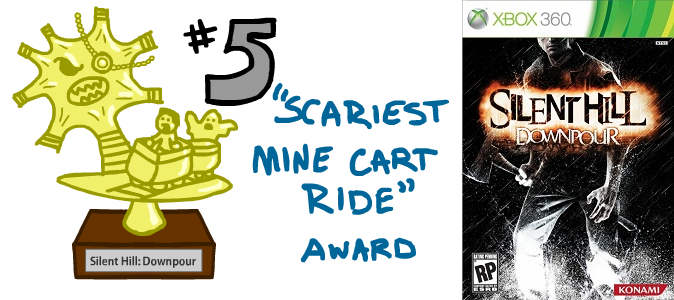
~ Silent Hill Downpour ~
Silent Hill and I go way back. Way, way back to when we’d go to my aunt and uncle’s house for birthdays/holidays and I’d play the demo of the original game over and over again. It was love at first fright, and while the franchise has some very sketchy entries, my adoration for it has never waned. All that patience paid of in 2009 when the amazing Silent Hill: Shattered Memories was released, and last year we were blessed with another excellent entry in the series with Downpour.
While Shattered Memories was notable because it did a great job of taking everything you knew about Silent Hill and turning it on its ear, Downpour is special because it plays like a more traditional SH game and does a great job of it. The series has been on a steady decline since the second game, and Downpour brings things back to a respectable level. Where its forebears would rely on silly, overcomplicated stories that could be really hard to understand due to a lack of exposition, Downpour tells a fairly simple tale of one man’s unwilling journey through the spooky town. The series has always had a pretty janky combat system, and while this game is no exception, it does make one very important change: giving you the ability to block enemy attacks. I think Homecoming may have had a block button, but I’m going to ignore it for the sake of making Downpour sound even better. Also, it has optional subquests! As far as I’m aware, this is the first time that’s ever happened in a straight survival horror game. It may sound like adding pointless busywork to what should be a very streamlined game, but most of them serve more to add character to the town than to distract you from your real goal. That makes them the best kind of subquests.
For all Downpour gets right, there are a few places where it misses the mark. I already said that the combat is still a little sub-par. There’s also some framerate issues when the game is loading stuff in the background, which won’t be overly noticeable on your first playthrough where you’re taking your time to explore. It’s on subsequent runs when you’re trying to speed your way through town that the hiccups really come out of hiding, and they get pretty bad at that point. This game’s incarnation of Silent Hill is fairly large, and word on the street is that you can unlock subway tunnels to help get around faster, but between three playthroughs I could not figure out how to unlock them. Maybe it’s easy and the blame is on me, but I think a faux fast travel system should be a little more obvious.
I’d be remiss if I didn’t mention that Downpour also has some of the absolute best Otherworld sequences in the series. They aren’t just playing a level the second time over with a spooky coat of paint: they’re entirely new areas and sometimes you won’t even know which world you’re in. Most of them are easy enough to point out, as the game likes to use the crumbly transitions from the movies to do immediate Otherworld swaps, but some of the Otherworld areas look like they could be real world locations, the difference being more in the events that play out in them. The one downside is that most creepy-style Otherworlds culminate in a Shattered Memories-esque escape sequence that has you running away from what appears to be some sort of tiny black hole. They’re not bad sequences, mind you, but rather than having a whole area to navigate your way through, most of these sequences are limited to forked hallways.
Downpour also does the horror part really well. The game is paced in a way that until you hit a certain point, you have no idea if you’re safe or not. Monsters are not always where you expect them, and have a tendency to pop out as soon as you start to feel comfortable and let down your defenses. A lot of the narrative horror is more along the line of morality, with murder and revenge being the themes of the day here. The subquests often have a little vignette attached to them, most of which range from “creepy because it could be real” scenarios to horrifying little wham moments. There isn’t a lot of fridge horror present here, which is something I’d expect more of following Shattered Memories, but I wouldn’t register that as a complaint. In the end, I was freaked right the hell out when I tried to play the game alone with the lights off, so I’ve got no choice but to consider it a success.
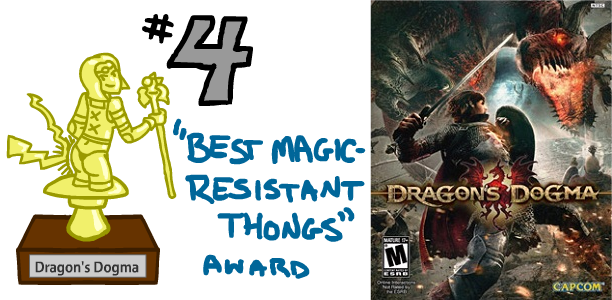
~ Dragon’s Dogma ~
Dragon’s Dogma is Capcom’s attempt to make an open-world RPG that appeals to the Western crowd. It’s also Capcom’s attempt to make a game by mashing together ideas from a handful of other video games. It’s also Capcom’s attempt to lure you into playing Monster Hunter. There are a lot of one-sentence ways to describe Dragon’s Dogma, but I think the best one is that it comes dangerously close to being my perfect game.
DragDog is an open-world RPG with a medieval flavour, and is most often compared to Skyrim. It is pretty much the opposite of Skyrim though, most notably in that it is very heavily focused on action as opposed to role-playing and exploring. Sure you can role-play, and there is exploring, but I’ve never been to into the whole role-playing thing and the game world is actually kinda small for this type of game (an unexpected boon because fast travel sucks here). I like this aspect of it because as much as I love exploring, the excitement of combat hits a lot more of those gratification buttons, and I think that’s the main reason why I’ve played through the game three(!!!) times. It also helps that for every dozen loading screens you’ll see in Skyrim, there will only be one in DragDog. I like games that don’t bog down a third of my play time with loading screens.
It also lifts a key idea from Demon’s/Dark Souls in that while it is an online game, you don’t ever really play with anyone else. DragDog gives you one pawn: a character who you create from scratch and who will follow you around for the duration of the game, fighting by your side and acting as the game’s hint system. You can hire two additional pawns to round out your party, and any pawns you hire will be those of other players. Pawns learn as they travel and fight, and when your pawn “returns from helping another Arisen” (they never really leave), they can bring back knowledge that can increase their effectiveness in combat or help you to solve some of those trickier subquests. I might also mention that as AI partners, pawns are incredibly competent fighters. They have a few little foibles, but in the end you can feel secure in the knowledge that your pawn has got your back. The one huge downside to them is that they never shut up. As you travel across the countryside they will constantly be shouting out random tidbits about the world and enemies. You’ll have learned after an hour with the game that goblins are weak to fire, but your pawn will never, ever let you forget.
The main attraction in DragDog is absolutely its stable of giant boss monsters. And this is where the game sometimes gets lumped in with Monster Hunter. The things you need to know are that MH is entirely about fighting giant beasts, and it’s a considerably slower, more thoughtful experience. DragDog’s boss monsters mostly just get in your way. You’ll rarely head out with the goal of slaying a cyclops or a chimera, but you’ll definitely come across a few on your travels. This works because you can just ignore all those chimeras if you’re tired of fighting them, but it’s a double-edged sword too, because the tougher and more exciting battles are quite a bit rarer. You’ll also have to jump through some hoops to fight these guys, whether it be trekking through a dungeon or having to stay at the inn over and over waiting for enough in-game days to pass for them to respawn. Compare to MH, where you mostly just pick out the thing you wanna fight and then fight it. It’s also a bit of a shame that there isn’t a whole lot of creativity in the bosses; the only one that isn’t a straight-up mythological beast (hydras, trolls, dragons, etc) is the Evil Eye, and that’s pretty much a Beholder straight out of D&D. I’m still waiting for Capcom to realize what a great idea it would be to have Monster Hunter monsters as DLC.
Monsters serve another purpose similar to the MH series: the spoils you win for beating them can be turned into armor and weapons. Only here you have to buy/find all your armor/weapons and the monster bits are just used to upgrade them. I do prefer collecting all of said bits to craft my own armor pieces, but the reality of the situation is that the DragDog way is much more efficient. Upgrading armor generally requires much fewer items than crafting new armor pieces does in MH, and you won’t need loot with a 2% drop rate to forge halfway decent stuff. In fact, good gear is fairly easy to come by, and money is handed out very liberally. I spent most of my time in the game with somewhere over two million pieces of gold on me.
One other thing you might like to know about DragDog, and something that I have an immense amount of respect for, is that it’s a pretty short game. In fact, it’s so short that I’m fairly sure that Capcom borked up the fast travel mechanics on purpose to make sure you didn’t beat it in one sitting. The game is easily beatable in under ten hours if you follow the plot to the tee, but it allows for (and encourages) you to spend time wandering about and seeing the world. I spent just a touch under 70 hours on my first playthrough, and hit about 15 on my second. I don’t know how long my third run took, but I’m sure it’s sitting well under ten on the hours scale.
Dragon’s Dogma might not be quite as high-profile as Skyrim, or as beloved by its niche as Dark Souls or Monster Hunter, but it absolutely hits all the right notes for me. It’s big, but pretty speedy. It gives you plenty of ways to play but remains fairly simple. It’s got huge monsters that you can climb up on top of and poke in the eye. Most of all, it’s a whole lot of fun. I don’t play many games more than once, but I’m already on my fourth run of DragDog. Hopefully the new Hard Mode lives up to its name, because the only real problem I’ve had with the game is that it’s far too easy.
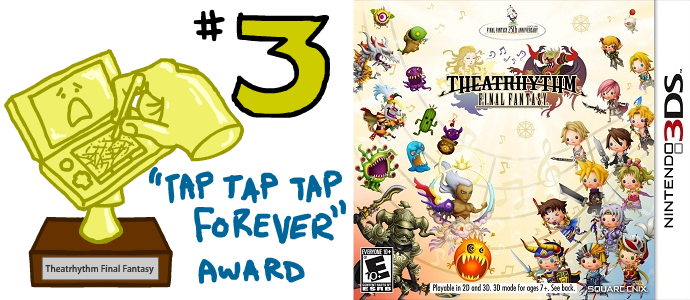
~ Theatrhythm Final Fantasy ~
Theatrhythm, Theatrhythm. I don’t even know where to start with this one. I guess I should explain it, yes? Theatrhythm Final Fantasy is a Final Fantasy rhythm game for the 3DS. It mainly consists of poking the touch screen to the rhythm, but sometimes you’ve gotta flick or drag too. It doesn’t really sound that compelling, but remember how Ouendan was imported so much that they made a North American sequel? When a rhythm game is good, it’s usually something really special.
Most notably, this rhythm game is loaded down entirely with music from the first 13 numbered Final Fantasy games. And yes, that even includes FFXI, because FFXI has some friggin’ amazing tunes. There are three game modes present, and the only one available at the start is Series Mode, which takes you through a selection of music from all 13 games. Each “stage” is based on one game, and features three songs from that game plus a prologue and epilogue song that are only playable here. After you complete a stage, it becomes available in Challenge Mode, which is essentially just the game’s way of saying free play. It’s kind of an outdated practice to not give you access to all the songs in free play from the outset, but it’s excusable because you can still start with whatever game you’d like on Series Mode.
There are three different classifications for songs too: battle music, field music, and event music. It should be pretty obvious how these are all defined, but maybe not as obvious that each style plays a little differently. In battle music, you’ve got four tracks on the screen (one for each party member), and you tap or swipe or whatever as notes fly down them and hit the target marker. Field music is similar, except there’s only one track, and sometimes you’ll have to hold the stylus down and drag it up and down to keep your target marker aligned with the note. Event music is completely different, and I think it’s best described as a “hands-off” Ouendan style. Here, the notes appear sequentially, and you tap or swipe the screen as your target marker flies over them. All the notes in all three types show up on the top screen, leaving you able to tap anywhere on the touch screen to register a note. I like it because it removes the physical accuracy aspect of Ouendan and makes the game all about keeping time with the music. Also there are no spinners.
Being a Final Fantasy branded product, of course there are also some delicious grindy RPG elements for players to enjoy. Each FF game is represented by its hero, and you’ll choose four of them to form a party. Every hero has a set of abilities that can help you through a song, and the heroes in your party will gain experience for each song played. Leveling up heroes teaches them new abilities and increases their stats, which have different effects each different music type. Occasionally you’ll earn items, which function kind of like character abilities, but are consumable. You also gain rhythmia points for playing songs, and upon reaching certain rhythmia thresholds, you’re awarded with all kinds of different unlockable goodies. Lastly, you will randomly be awarded collectible character and monster cards upon clearing songs. They don’t really do anything aside from yay, collecting!
The third and last game mode (did you think I forgot?) is Chaos Shrine, and this is where the game get really fun. You start with a single “Dark Note,” which is comprised of two randomly selected songs at random difficulty levels. When you complete a Dark Note you get a new one. This goes on and on forever, and the random nature of the Dark Notes mean that you’ll probably never get the exact same one twice. The goal of this mode, aside from random challenges, is to give you an easy(ish) way to grind for items and crystals. But mostly just the crystals, because earning so many crystals of a certain colour will unlock a new character for you to enlist into your party. You can also swap Dark Notes with other people via Street Pass, which is a handy way to build up your collection if you’re stuck on a particularly hard one.
Now that you know the basics of how it works, you might have a better understanding of why I like it so much. If you still don’t get it, here are a few major points: a) Battle party containing both Lightning and Squall. b) A game that is entirely focused on Final Fantasy music. c) Grinding levels by tapping along to to Final Fantasy music. d) Collectible cards. If Dragon’s Dogma is special because I’ve beaten it three times in the span of half a year, then Theatrhythm is special because it was the only 3DS game that I played for three months. That’s saying a lot because I spend at least half of my total gaming time with my 3DS. The only game with more use on the thing is Pokémon White 2 and well, it’s Pokémon, so it obviously wins in hours. In terms of pure fun though, Theatrhythm is absolutely in the number one spot for 2012 portable games.
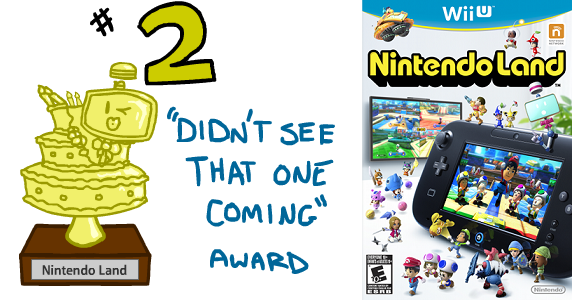
~ Nintendo Land ~
The fourth and third place write-ups were pretty long, and while I think that my top two games of the year should be treated to equal treatment, I feel like it would be best to be more concise with them. For Nintendo Land, I think the overall theme of this write-up is going to be “surprise.”
Nintendo Land itself is the biggest surprise of the year for me. When it was first showed at 3E, I, along with most of the internet, was underwhelmed. It looked like a new Wii Sports with Nintendo characters slapped on top to cash in on nostalgia trippers. It couldn’t be more the opposite. Wii Sports is accessible and fun, but it’s pretty shallow. When you’re playing alone, you just continually play one slightly better AI player after another forever. Any one game in Nintendo Land is more complicated than all the sports on Wii Sports. They’re made more for gamers than grandmas, and I thank God every day for that.
Nintendo Land is also an incredibly deep game. It has twelve games, each one radically different from the next, and each one offering a unique way to use the GamePad. Three of those games are purely competitive and require at least two players. They are the least complicated, but have the best multiplayer fun potential. There are 6 single-player games, and while most of them are pretty short and sweet, there’s more than meets the eye here. When you complete any given game once, a second playthrough will be followed up by an extra, harder mode. The last three games can be played solo or cooperatively, and each has a series of stages to progress through. What happens when you complete all the stages in one of the games? A whole new set of stages unlocks. There is so much more game to Nintendo Land than we were shown at E3. If Nintendo had made this more obvious then, hype for the game probably would have existed.
There are more surprises in store, too! There is a small hub in which you can march your Mii around before you select a game to play. You’ll earn coins by playing games, and those coins can in turn be used in what I call Nintendo Plinko. Victories on Plinko will cause the tower in the middle of the plaza to spew out question blocks. Opening these question blocks will reveal all sorts of things, including props from the various games, music that you can play on a jukebox, and huge buttons that have random and somewhat mysterious effects. This is a great little meta-game that adds so much more charm to the whole package.
The last surprise in Nintendo Land is just how much fun it is. To be completely honest, I wasn’t expecting a whole lot. I was glad that it was a pack-in with the Wii U because it did not look interesting enough to warrant a purchase on its own. But it is. Oh, how it is. Playing any of the solo games is a good time in itself, and some of the games are absolutely addictive in their simplicity. None are easy though, and when you beat one and think you’re good at it, the aforementioned hard modes will knock you back down a couple pegs. The multiplayer is where Nintendo Land really shines though, and while the co-op games are great and have the most depth of them all, the competitive games provide the most pure fun. Each is a competition between the GamePad holder and everyone else, and while that might seem unfair, the games are balanced almost perfectly to work this way. Simply put: they are a blast.
I honestly don’t remember having as much fun playing games with other people as when the wife and my brother join me for some Nintendo Land. I’m fairly sure that Wii Sports didn’t get as much play in my house through its lifetime as Nintendo Land has in its first month and a half. It’s an amazing game, and I couldn’t be happier with how it turned out. Only time will tell for sure, but I’m going to go out on a limb here and suggest that Nintendo Land might be an even better pack-in game than Super Mario World. Flame bait set.
Huh. So much for concise.
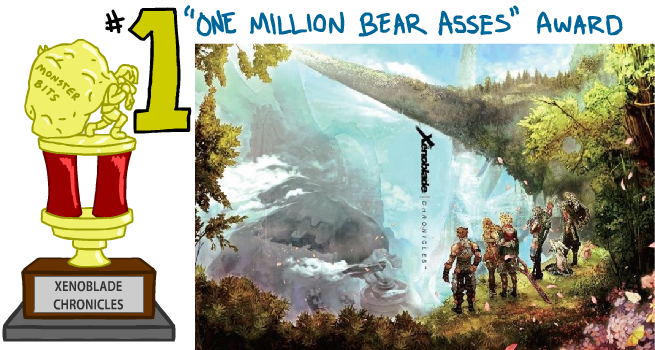
~ Xenoblade Chronicles ~
I don’t know if you saw this one coming. I sure didn’t. A lot of people I know on the internet are hailing silly games like Journey and The Walking Dead as game of the year, but I just don’t feel it that way (also I didn’t play those). To each his own and all, but for me, I absolutely have to put my chips in with the silly game that almost didn’t even get a release in North America.
Xenoblade Chronicles is a JRPG. Let’s get that out right now. That means that it absolutely comes with a lot of the silliness and boneheaded stupidity that the genre is maligned for. But it also goes its own way and subverts a lot of the expectations that you might have for it. Number one being the battle system. There is no battle dimension in Xenoblade. It’s all in real-time on the same map you run around on. It’s a lot like Final Fantasy XII in the way that you see monsters, and your dude automatically attacks them. You’re still in control of moving your guy around and using his special moves though, and this is important. You can charge through some of the lesser mooks without pressing a button, but most of the time you’re going to want to use those special skills, and even position is important because it can affect damage output and trigger the special effects of certain abilities. Most importantly is that all monsters behave differently. Some never attack you, some only go aggro if you hang around them too long. Every single one of them will leave you alone if you’re X levels stronger than they are.
Battles are fun, and they are the heart of the game, but the soul resides within the world itself. Xenoblade’s story takes place on the bodies of two gigantic creatures known as Bionis and Mechonis. One is home to organic creatures of all types, while the other plays host to robots and other mechanical life forms. What they have in common is amazing scenery. The game areas are enormous, and every single one of them has at least one point where you can take in an absolutely breathtaking view. From the lush green plains and eye-popping rock formations of the Bionis’ Leg to the distant fingertip of the Mechonis’ Fallen Arm, the world is huge and beautiful , and makes even the most gorgeous sights of the real world pale in comparison. In fact, there’s one weather condition in the Eryth Sea area that just might ruin your appreciation for real-world beauty altogether. Just looking at this game can inspire awe, and it’s all the better for it.
Of course, there’s got to be plenty to do in such a large game world. Xenoblade doesn’t hurt for ways to fill the space. Monsters populate every area, and they have a vast range of levels, so that you’ll have a reason to come back and visit the early game areas when you’re nearing the end. The main story line is said to take about 60 hours to complete, but I have no idea how accurate that is because my save file clocked in at just shy of 150 when I finished it. Needless to say, there are subquests. So many subquests that it almost gives Skyrim a run for its money in the “mindless chores” section. Most of said subquests require you to collect so many pieces of loot, or to slay so many of a specific enemy, hence the silly award title. There are some more interesting ones, and those ones obviously have the best prizes. It should be noted that the bulk of these subquests come from unique NPCs, of which there are so many that there is an in-game chart to keep track of where everyone lives, what time of day you can talk to them, who they know, etc etc. Every single one of them has a little story to tell too, and while most of those stories are told only once you’ve rounded up your twenty bear asses, they’re worth it for the great sense of world building.
It’s worth noting that the game does its best to help you achieve your goals too. There are plenty of fast travel points across the game’s many maps, and unlike DragDog, you don’t have to pay to use them. There’s also a day/night cycle in the game, but the developers were generous little bastards and programmed in the ability to set the in-game time to whatever you’d like. This removes the tedium from all those quests that ask you to hunt monsters who only come out at specific times of the day. You can’t select weather conditions freely, but quests that rely on weather are exceedingly rare and whenever you change the time, the game re-rolls for weather, making it pretty easy to get rain or sun or whatever you need.
The main characters are all likable in their own way, but three of them stand out to me. I’ve already written up a thing about why I think Shulk is a good main character, and while that was written less than halfway through the game, I feel like it holds up. Shulk has a solid motivation and the means to achieve his goals. He has a respectable amount of character growth, and simultaneously is and is not the Chosen One. Riki, on the other hand, is lovable just because he’s so damn lovable! Part of the team’s comedy relief duo, Riki is a little on the slow side, but puts his heart into everything. All he wants in life is to be a good husband, father and friend. What better motivation could there possibly be? Maybe it’s not deep or original, but I think heartfelt wins out over pretentious. The last character I like is the last character to join the party and a big ol’ spoiler, whom I am a fan of almost entirely for gameplay reasons. I won’t say much, but this character is just so much fun to play as that I had trouble swapping them out as party leader for anyone else once they were recruited.
The game’s story is a point of debate among fans. Some think it’s great, some thing it’s trash, others think it starts great and ends as trash. I liked it through and through. Maybe not in love with some of the sillier and more cliche twists in the last quarter, but I’ve seen a lot worse. It does nearly hit the critical mass of anime wackiness towards the end, but the thing about that is that I don’t watch anime, so it’s not cliche and overwrought to me. The very ending, the last big twist? I thought it was great, even thought I’ve heard so many others groan about how dumb it is. I didn’t see it coming at all, and it wasn’t a thing that I’ve ever seen anything even close to before, so it’s alright by me. At the very, very least, it allowed for a really amazing lead-up to the final showdown.
Xenoblade Chronicles is a dense game, and it’s really easy to get overexcited about it and stall out about 30% of the way through. I did and I know a bunch of other people who did. I’m so glad that I got back on the train and saw it through to the end though. It was a unique experience, and a perfectly refined example of what the JRPG genre can be when the devs get it right. In other words, it’s Final Fantasy XII with most of the bullcrap and Star Wars references cut out. It’s my game of the year, and it absolutely deserves the spot. So what the hell was Reggie thinking?
